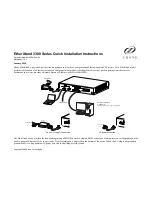
Copyright 2008, Zhone Technologies
Loop bonded WAN SHDSL lines
Using two, four, or up to eight SHDSL lines for one network connection (loop bonding) will net the respective speed and data
passing capability as a single SHDSL connection. Multiple SHDSL lines used for one connection also provide backup for each
other should one or more of the lines become disabled.
Establishing a loop bonded connection
1
Plug your SHDSL cables into the SHDSL RJ-45 ports (any combination of SHDSL ports) on the rear of the device. The order of the connection
is not important.The 4-port models use SHDSL ports 1 to 4.
2
Verify all connections. The SHDSL Link LED for each connected port flashes green to indicate the connection is established and operational.
Establishing a single line connection
1
Plug your SHDSL cable into one of the SHDSL RJ-45 ports on the back of the device. The 4-port models use SHDSL ports 1 to 4.
2
Verify your connection. The SHDSL LED corresponding to the connected port flashes green to indicate the connection is established and
operational.
LAN Ethernet lines
Connect the end-user lines into the LAN ports. Before an SHDSL connection is made, the Ethernet LAN links are disabled. The LEDs are off until
at least one SHDSL links is established.
Setting auto-negotiate and duplex mode
The 10/100 Ethernet ports auto-negotiate speed and duplex mode in accordance with the remote equipment to which they are connected. See the
EtherXtend User’s Guide
for instructions on setting port speed and mode.
•
Half Duplex - Receive and transmit functions are mutually exclusive; data transmission occurs in only one direction at a time. Packet collisions
are unusual.
•
Full Duplex - Receive and transmit functions occur simultaneously, effectively doubling aggregate bandwidth and preventing packet collisions.
For the best connection results, it is recommended to set the remote devices to autonegotiate speed and duplex mode. If the remote device cannot be
configured to autonegotiate, speed may be set at either 10 Mbps or 100 Mbps. However, duplex mode on the remote devices must be set to half
duplex.
Refer to the
EtherXtend 3300 Series 1.14.1 Release Notes
for concise instructions on logging on, adding a EFM or N2N bond group, adding links,
and building a bridge in order to pass traffic on the EtherXtend.
For complete EtherXtend product documentation, see http://zhone.com/support/manuals/




















